June 15, 2025 | 16:25 GMT +7
June 15, 2025 | 16:25 GMT +7
Hotline: 0913.378.918
June 15, 2025 | 16:25 GMT +7
Hotline: 0913.378.918

Quang Lanh Agricultural Cooperative members in Kien Xuong district, Thai Binh province, has earned sizeable income from selling baled straw after the rice harvest. Photo: Thai Binh.
Ms. Tran Thi Lanh, Director of Quang Lanh Agricultural Service Cooperative in Binh Minh commune, Kien Xuong district, is a pioneer in the recent large-scale farming movement. She decided to invest in a straw baling machine to pilot the on-field collection of straw.
For the previous crops, rice husks, straw, and other rice residues from the cultivated land were unutilized and left to waste in fields, and only the rice were collected. Traditionally, rice husks and straw were either left in the field or discarded by burning or soaking in water before plowing them into the soil.
This old traditional method resulted in the wastage of straw. Moreover, the smoke from the burning was one of the factors causing air pollution, leading to dust and low air quality in rural areas. During past harvest season, various provincial governments in the Red River Delta region have issued warnings to discourage the local on-field burnings and to protect the environment.
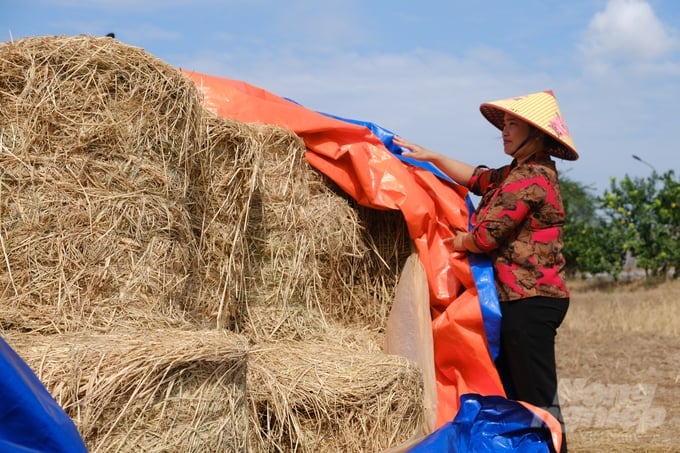
Ms. Tran Thi Lanh next to a stack of raw straw materials. Photo: K. Trung.
In preparation for the recent rice harvest season, Ms. Lanh invested in a small straw baling machine to experiment with harvesting straw. "This small machine, connected to the plow, was invested by the cooperative to experiment with baling straw. If it proves effective, we will upgrade to a larger capacity machine for the next crop," stated Ms. Lanh.
Ms. Lanh harvested 2,000 bales of straw for this crop's harvest. The cooperative allocated an empty area of several thousand square meters for straw storage. The massive piles of straw were covered with tarpaulin to shield them from rain. Subsequently, the covers were removed during sunny weather to air and dry the straw.
Despite being an experimental model of straw baling, Ms. Lanh has sold 1,000 straw bales at a price of 20,000 Vietnamese dong per bale, amounting to a total of 20 million Vietnamese dong. Straw transportation truck travel directly to the cooperative on a daily basis for purchase and distribution.
"Farmers typically buy straw as a raw material for producing mushroom, animal feed for cattle, especially dairy cows. Organic mushroom farming models are currently trending, so the demand for straw is quite substantial. Many small-scale pig farms have considered returning to the straw bedding model to produce fertilizer for agriculture. As a result, straw and husks hold immense practical value," explained Ms. Lanh.
According to agricultural experts, one hectare of rice yields approximately 10 tons of straw. After being processed with biological products, this amount of straw can produce at least 4 tons of organic fertilizer. As a result, processing the total 45 million tons of straw nationwide can provide nearly 20 million tons of organic fertilizer, significantly reducing the need for farmers to purchase chemical fertilizers. This is equivalent to 200,000 tons of urea, 190,000 tons of phosphate, and 460,000 tons of potash. Consequently, farmers nationwide can save nearly 11,000 billion Vietnamese dong in fertilizer costs.

Over the years, the Ministry of Natural Resources and Environment and various local governments have issued strict directives prohibiting the burning of straw and husks due to the alarming level of air and environmental pollution. Photo: Thu Cuc.
Straw and husks can utilized to increase soil fertility. Farmers from several provinces and cities have utilized new-generation combine harvesters to cut and spread the straw directly onto the fields. Subsequently, a brief period of microorganism processing will break down the straw into organic fertilizer.
In the northern provinces of Vietnam, the harvesting of straw and husks has not received priority. Local farmers often leave straw in the fields after the rice harvest, leading to a considerable amount of thick smoke and dust when burned. In response to this environmental issue, numerous local governments have issued strict directives prohibiting the burning of straw and husks to protect the environment. The Ministry of Natural Resources and Environment has also issued various directives urging local governments to coordinate and strengthen measures to control air pollution in provinces and cities within the Red River Delta region.
Environmental experts suggest that in addition to known causes such as emissions from transportation, construction, and industrial activities which generate significant and uncontrolled pollution, unfavorable weather conditions during the transitional seasons also contribute to air pollution. Another significant factor is the burning of straw and agricultural residues after harvest by farmers. This annual and recurrent activity in rural areas within the northern region of Vietnam currently lacks an effective and comprehensive solution.
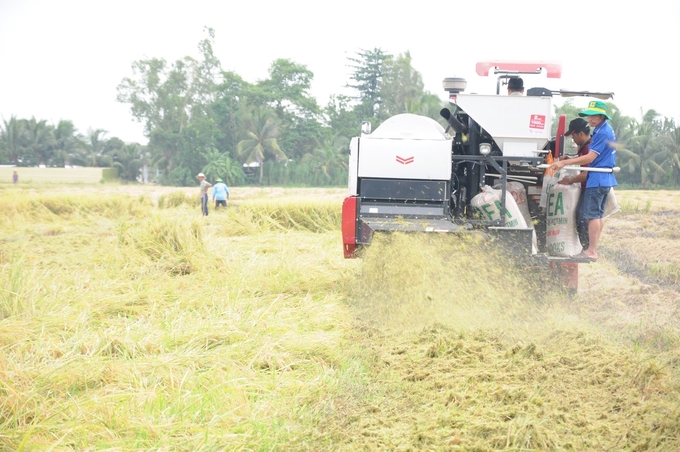
A combine harvester to finely shred straw for processing into fertilizer. Photo: Trung Chanh.
In an effort to control and minimize environmental air pollution, the Ministry of Natural Resources and Environment has suggested local governments to uniformly implement measures to raise awareness and discourage citizens from burning household waste, straw, and agricultural residues after the rice harvest. Furthermore, local Farmer's Association, Women's Union, and Youth Union have directed their members to not burn straw and agricultural residues in the fields.
Moreover, local governments have been urged to develop projects and directives in guiding farmers to implement comprehensive strategies for collection, processing, and efficient conversion of post-harvest agricultural residues and straw into useful products.

Farmers are able to generate additional income from harvesting and utilizing post-harvest straw and agricultural residues.
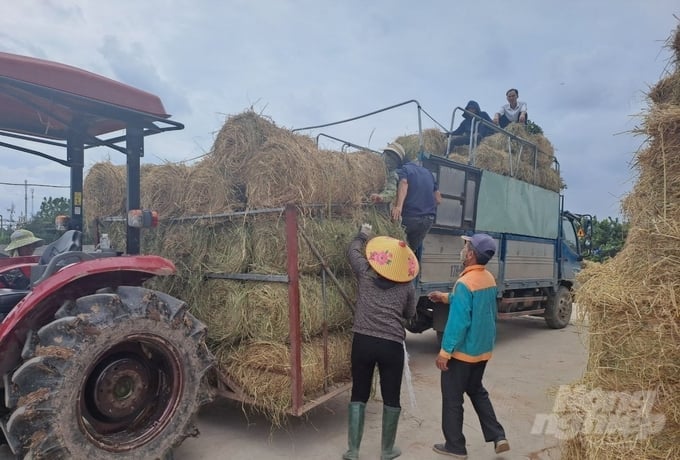
Each bale of straw currently yields approximately 20,000 Vietnamese dong of profit, with the highest being 30,000 Vietnamese dong. This can constitute a significant revenue stream if farmers are ably to fully utilize agricultural by-products. Photo: Kien Trung.
Experience from rice fields in the Mekong Delta region
Mr. Trieu Quoc Duong, Deputy Head of the Technical Department at the Agricultural Extension Center under Hau Giang province's Department of Agriculture and Rural Development, shared: Farmers in the Mekong Delta region have earned a considerable income from selling post-harvest straw for several years. A bale of dry straw can be sold at approximately 20,000 Vietnamese dong in the fields, with each freshly harvested bale weighing up to 40 kilograms. Harvesting straw also helps subsequent soil preparation for following crops by facilitating land cultivation. Namely, freshly harvested straw can become obstacles in land preparation for the new rice crop before they are ultimately decomposed.
Mr. Tran Van Trieu from Ward 6, Vi Tan Commune, Vị Thanh city, Hau Giang province, spends a substantial amount of money annually to purchase straw for the production of mushroom. After using the straw for mushroom production, the remaining husks are decomposed. Subsequently, Mr. Trieu collects the decomposed residues to produce organic fertilizer, effectively rejuvenating the soil. "Utilizing agricultural by-products helps reduce production costs, organically enhances soil nutrition, and contributes to environmental protection," Mr. Trieu emphasized.
Translated by Nguyen Hai Long
![Turning wind and rain into action: [4] Bringing climate bulletins to remote and isolated areas](https://t.ex-cdn.com/nongnghiepmoitruong.vn/608w/files/linhnhp/2025/06/14/1152-z6704423696987_15fd32ffc26d590d204d520c9dac6786-nongnghiep-151141.jpg)
(VAN) The Vietnam Agriculture and Nature Newspaper interviewed Mr. Vu Thai Truong, Acting Head of Climate Change and Environment at UNDP Vietnam, to gain deeper insight into how climate bulletins are delivered to farmers.
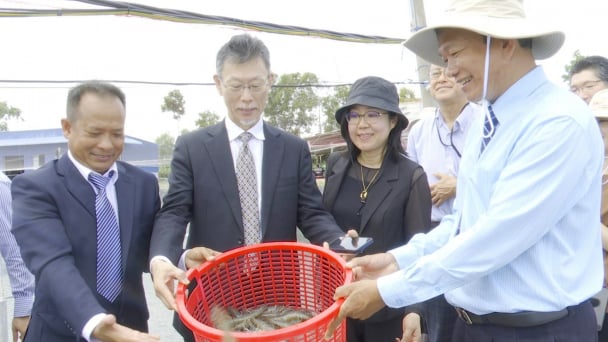
(VAN) In Tien Giang, a high-tech shrimp farm has developed a distinctive energy-saving farming model that has yielded promising results.
![Turning wind and rain into action: [3] 300.000 farmers benefit from agro-climatic bulletins](https://t.ex-cdn.com/nongnghiepmoitruong.vn/608w/files/news/2025/06/12/e5a48259d6a262fc3bb3-nongnghiep-125122.jpg)
(VAN) The agro-climatic bulletin has become a valuable tool for farmers in the Mekong Delta. After more than five years of implementation, the initiative is gradually being expanded nationwide.
![Turning wind and rain into action: [2] Providing forecasts to the people](https://t.ex-cdn.com/nongnghiepmoitruong.vn/608w/files/news/2025/06/12/e5a48259d6a262fc3bb3-nongnghiep-103927.jpg)
(VAN) In addition to improving the quality of hydrometeorological forecasts, putting forecast bulletins into practical use is crucial for production and disaster prevention.
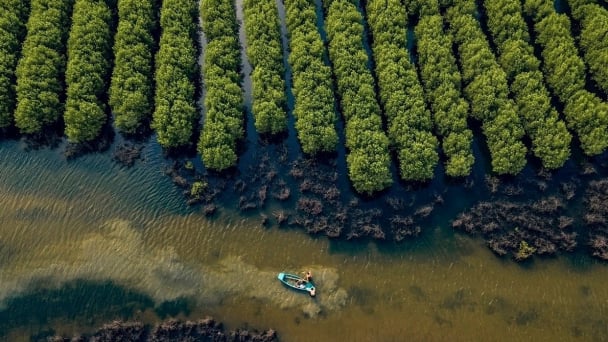
(VAN) Blue carbon is receiving attention for its rapid absorption capacity and vast potential. It represents a promising nature-based solution to respond to climate change.
/2025/06/11/3507-1-161904_583.jpg)
(VAN) Seagrass beds and coral reefs serve as 'cradles' that nurture life in the ocean depths, creating rich aquatic resources in Vietnamese waters.
![Turning wind and rain into action: [1] Forecasting for farmers](https://t.ex-cdn.com/nongnghiepmoitruong.vn/608w/files/news/2025/06/11/e5a48259d6a262fc3bb3-nongnghiep-111919.jpg)
(VAN) Weather is no longer just a matter of fate. Forecasts have now become an essential companion for farmers in every crop season.